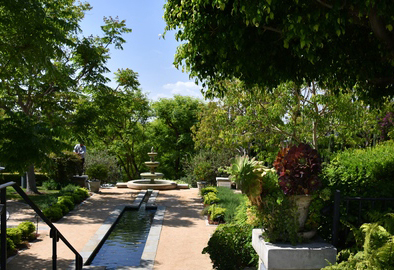I had read about the Peace Awareness Labyrinth and Gardens, located at 3500 West Adams, in the online magazine LAist over a year ago, but did not visit it until yesterday.
I planned to meditate about the end the year in this “spiritual oasis,” and I did, but what I wasn’t expecting was to connect with my Italian heritage. I discovered that the elegant Guasti Villa, that now houses the PAL&G, was built by a wealthy Italian immigrant in 1910.

Secondo Guasti, born in 1859 in Monbaruzzo, province of Asti, in the Northern Piedmont region, emigrated via Mexico to Los Angeles in 1883, arriving with one dollar in his pocket. He found work as a cook at the Italian hotel and restaurant Italia Unita, located in the Avila Adobe on Olvera Street. In 1887 the enterprising young man, then 28, asked the proprietors for the hand of their 15-year-old daughter Louisa Amillo, and their happy marriage lasted 40 years until his death. Secondo bought cheap land in the Cucamonga Valley near Ontario, an arid desert where the soil was good but the water scarce, and in 1900 founded with several partners the Italian Vineyard Company, the largest in the world at 5700 acres, producing 5 million gallons of wine a year by 1917. In 1912 he built a small town called Guasti for his 1,200 Italian and Mexican workers, with a school, a market, a bakery, a library, a firehouse, a doctor’s office, and in 1926 a Catholic church, San Secondo d’Asti, modeled after the one in his hometown, named after its patron saint.
Read Guasti’s story in this 2000 LA Times Times article “From Penniless Immigrant to Wine King”

I had found out about the history of Italian immigrants in Los Angeles 3 years ago, while visiting the newly opened Italian-American Museum, IAMLA. You may read my article in Cultural Weekly at this link. Guasti is mentioned in the 2009 book Los Angeles’s Little Italy by Mariann Gatto, with vintage photos.

As docent Ryan lead us through the Guasti Villa, we learnt that it was built in 4 years between 1910 and 1913, at the cost of $500,0000, in the Beaux-Arts style inspired by the Italian-Renaissance, with symmetrical architectural elements like arches and Greek columns. We admired the Carrara marble tile floor of the veranda, the grand ballroom lined with inlaid oak wood, the large oval ceiling fresco depicting the lady of the house Louisa among the clouds, with her surviving son Secondo Jr. (four more children who died appear as angels). An inscription reads in Latin “spez mea in deo=my trust is in God.” A curved staircase leads to the upper level, that we didn’t get to visit, arches open to the two parlors, one for men to smoke their cigars and drink their liqueurs after dinner, with a rose marble fireplace, and one for women, that was separated by a wall, and used to have ornate wallpaper, now preserved in a frame. On the opposite side we entered the dining room, also with an ornate mantelpiece, and tapestry lining the upper walls; one figure pictured is Bacchus the Roman God of wine.

It’s in this room that some of us took advantage of the offer of a sound meditation to connect with our soul, which is held monthly on Tuesday evenings at this spiritual center now headquarters of the MSIA church (Movement of Spiritual Inner Awareness) founded in 1968, and of the PTS (Peace Theological Seminary) founded in 1977 by John-Roger Hinkins, who had been raised Mormon in Utah. In 1988 he passed the “keys” to what he called “Mystical Traveler Consciousness” to current leader John Morton. In 1976 Hinkins also founded USM (University of Santa Monica), that offers a Masters Degree in Spiritual Psychology. He died in 2014.

We then were shown how to walk the labyrinth, a circular path on the ground, made of travertine marble, modeled after the one at the Chartres Cathedral in France, added in 2002. You have to set your intention for this walking meditation, ask for the LIGHT (Living in God Holy Thought). See more info at this link

Finally I descended among fountains to the 3 lower levels of gardens, filled with plants like ferns, huge birds of paradise, tall bamboo, citrus trees, I stopped to look at the red fish in the koi pond, I sat under a gazebo on a wooden bench to meditate.
The Guasti Villa is available for rent for movie and TV shoots; recently it served as a set for the television comedy Veep. Click here for 2017 article with many photos.
The mansion was used for lavish parties during the lifetime of their original owners; they ever published their family recipes in a cookbook. Click here for 1994 LA Times article.

After Secondo’s death in 1927, his widow continued to live there with her son, who died in 1933 at age 42, her daughter-in-law Gertrude remarried in 1935 and moved to New York. At Louisa’s death in 1937, the house was bought by Hollywood choreographer and director of movie musical Busby Berkley, who sold it in 1946. It was purchased by the Los Angeles Physicians Aid Association, who transformed it into a retirement home, adding two residential wings in the back. MSIA acquired the property in 1974 and spent more than 20 years to restore it to its original splendour. It was declared a Historical-Cultural Monument in 1990.
The Peace Awareness Labyrinth and Gardens are open to the public Tuesdays-Fridays, some Saturdays and Sundays, from 12 noon to 4pm, attending a tour is required. Reservations must be made through Evite. Free, $10 donation suggested. Click on this link to register.
Text by Elisa Leonelli
Photos courtesy of PAL&G

